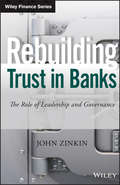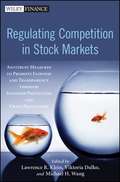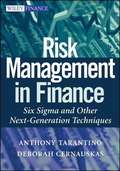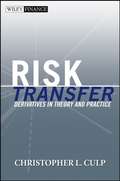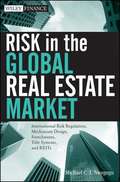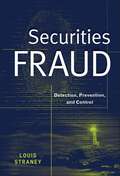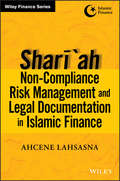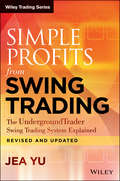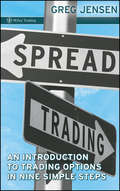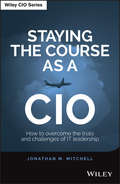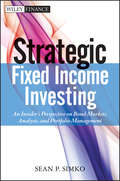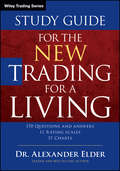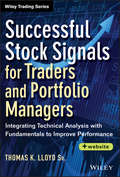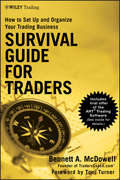- Table View
- List View
Rebuilding Trust in Banks
by John ZinkinAn outline of the core principles and strategies required to restore the credibility of the global finance industrySince 2008, the global financial industry has lurched from crisis to crisis, calamity to calamity, resulting in an epic loss of public trust in banking and financial institutions. Rebuilding Trust in Banks argues that this series of disasters have usually been the result failures of leadership and governance, combined with unenforced systems of checks and balances. Often, leaders lose their way, believing their own hype and buying into their own propaganda. The more successful these leaders are initially the greater their self-confidence grows along with the certainty that they're right. The result is a dangerous hubris with no countervailing power to stop or change reckless, unethical, or self-interested strategies. This book offers a solution, with useful benchmarks for corporate governance and a global perspective.Features effective best practices for ensuring good corporate governance and responsible leadership in banking and financeWritten by a renowned expert in corporate governance with more than 40 years of experience, particularly in AsiaIntended for corporate leaders and board members in financial companies, as well as regulators, advisors, and studentsIf banks and other financial institutions truly want to rebuild the trust they once enjoyed, this practical and prescriptive guide offers effective best practices that can--and should--be widely implemented throughout the industry.
Regulating Competition in Stock Markets
by Lawrence Klein Michael Wang Viktoria DalkoA guide to curbing monopoly power in stock marketsEngaging and informative, Regulating Competition in Stock Markets skillfully analyzes the impact of the recent global financial crisis on health and happiness, and uses this opportunity to put regulatory systems in perspective. Happiness is lost because of emotional and physical health deterioration resulting from the crisis. Therefore, the authors conclude that financial crisis prevention should be the focus of public policy.This book is the most comprehensive study so far on potential risks to the stock market, especially various forms of market manipulation that lead to mania and eventual crisis. Based on litigation cases from international stock markets, and borrowing multidisciplinary findings in the fields of finance, economics, accounting, media studies, criminology, legal studies, psychology, and medicine, this book is the first to provide thorough micro-level regulatory proposals rooted in financial reality. By focusing on securities trading, they apply antitrust measures to limiting monopolistic power that is used for the manipulation of investors' perception and monopolistic profit. These proposals are quantifiable, adjustable, inexpensive, and can be easily implemented by any securities regulating agency for real-time oversight and daily operations.The recommendations found here are intended to improve the fairness and transparency of the financial markets, thereby perfecting the market competition, protecting investors, stabilizing the market, and preventing crisesExplores how avoiding crises can to contribute to a more scientific, health aware, and civilized economic and social developmentWritten by a team of authors who have extensive experience in this dynamic field, including Nobel Laureate Lawrence R. KleinSince the founding of the first, organized stock exchange in Amsterdam 400 years ago, no systematic economic research results on stock markets have been implemented in stock market regulation around the world. Regulating Competition in Stock Markets aims to fill this void.
Regulating Wall Street
by Viral V. Acharya New York University Stern School of Business Matthew P. Richardson Myron Scholes Ingo Walter Thomas F. CooleyExperts from NYU Stern School of Business analyze new financial regulations and what they mean for the economyThe NYU Stern School of Business is one of the top business schools in the world thanks to the leading academics, researchers, and provocative thinkers who call it home. In Regulating Wall Street: The New Architecture of Global Finance, an impressive group of the Stern school's top authorities on finance combine their expertise in capital markets, risk management, banking, and derivatives to assess the strengths and weaknesses of new regulations in response to the recent global financial crisis.Summarizes key issues that regulatory reform should addressEvaluates the key components of regulatory reformProvides analysis of how the reforms will affect financial firms and markets, as well as the real economyThe U.S. Congress is on track to complete the most significant changes in financial regulation since the 1930s. Regulating Wall Street: The New Architecture of Global Finance discusses the impact these news laws will have on the U.S. and global financial architecture.
Restoring Financial Stability: How to Repair a Failed System (Wiley Finance #542)
by Matthew Richardson Viral Acharya New York University Stern School of BusinessAn insightful look at how to reform our broken financial systemThe financial crisis that unfolded in September 2008 transformed the United States and world economies. As each day's headlines brought stories of bank failures and rescues, government policies drawn and redrawn against the backdrop of an historic Presidential election, and solutions that seemed to be discarded almost as soon as they were proposed, a group of thirty-three academics at New York University Stern School of Business began tackling the hard questions behind the headlines. Representing fields of finance, economics, and accounting, these professors-led by Dean Thomas Cooley and Vice Dean Ingo Walter-shaped eighteen independent policy papers that proposed market-focused solutions to the problems within a common framework. In December, with great urgency, they sent hand-bound copies to Washington. Restoring Financial Stability is the culmination of their work.Proposes bold, yet principled approaches-including financial policy alternatives and specific courses of action-to deal with this unprecedented, systemic financial crisisCreated by the contributions of various academics from New York University's Stern School of BusinessProvides important perspectives on both the causes of the global financial crisis as well as proposed solutions to ensure it doesn't happen againContains detailed evaluations and analyses covering many spectrums of the marketplaceEdited by Matthew Richardson and Viral Acharya, this reliable resource brings together the best thinking of finance and economics from the faculty of one of the top universities in world.
Reverse Engineering Deals on Wall Street with Microsoft Excel + CD
by Allman Keith A.A serious source of information for those looking to reverse engineer business deals It's clear from the current turbulence on Wall Street that the inner workings of its most complex transactions are poorly understood. Wall Street deals parse risk using intricate legal terminology that is difficult to translate into an analytical model. Reverse Engineering Deals on Wall Street: A Step-By-Step Guide takes readers through a detailed methodology of deconstructing the public deal documentation of a modern Wall Street transaction and applying the deconstructed elements to create a fully dynamic model that can be used for risk and investment analysis. Appropriate for the current market climate, an actual residential mortgage backed security (RMBS) transaction is taken from prospectus to model by the end of the book. Step by step, Allman walks the reader through the reversing process with textual excerpts from the prospectus and discussions on how it directly transfers to a model. Each chapter begins with a discussion of concepts with exact references to an example prospectus, followed by a section called "Model Builder," in which Allman translates the theory into a fully functioning model for the example deal. Also included is valuable VBA code and detailed explanation that shows proper valuation methods including loan level amortization and full trigger modeling. Aside from investment analysis this text can help anyone who wants to keep track of the competition, learn from others public transactions, or set up a system to audit one's own models. Note: CD-ROM/DVD and other supplementary materials are not included as part of eBook file.
Risk Management in Finance
by Anthony Cernauskas Deborah TarantinoImplement next-generation techniques-before disaster strikes-and improve operation risk management "The recent global economic crisis has brought home the need for realistic operational risk management as an important element of an organization's survival strategy in turbulent times. In Risk Management in Finance Dr. Tarantino and his coauthors provide an operational risk framework for the twenty-first-century organization by culling the state-of-the-arts knowledge on next-generation techniques in financial risk management to forestall major risk management failures. This book represents a landmark contribution in attempting to create a corporate world that is able to cope with major crisis. The book should be on the must read list for all those interested in reforming corporate governance. " -Dr. Anwar Shah, Lead Economist and Program Leader, Governance, World Bank Institute "As operational risk management advances, interest in process-centered risk management has grown. This timely book presents a valuable overview of leading-edge theory and practice. " -Simon Wills, Executive Director, Operational Riskdata eXchange Association (ORX), the world's largest banking association for sharing operational loss data
Risk Transfer
by Christopher L. CulpBased on an enormously popular "derivative instruments and applications" course taught by risk expert Christopher Culp at the University of Chicago, Risk Transfer will prepare both current practitioners and students alike for many of the issues and problems they will face in derivative markets. Filled with in-depth insight and practical advice, this book is an essential resource for those who want a comprehensive education and working knowledge of this major field in finance, as well as professionals studying to pass the GARP FRM exam.Christopher L. Culp, PhD (Chicago, IL), is a Principal at CP Risk Management LLC and is also Adjunct Professor of Finance at the University of Chicago. He is the author of Corporate Aftershock (0-471-43002-1) and The ART of Risk Management (0-471-12495-8).
Risk in the Global Real Estate Market
by Mike C. NwoguguEssential reading for professional investors, risk managers, regulators, central bankers, and real estate professionals, Risk in the Global Real Estate Market: International Risk Regulation, Mechanism Design, Foreclosures, Title Systems, and REITs takes an international look at the ways in which U.S.-style constitutional laws, financial laws, and real estate laws in various countries affect global economics and risk; and analyzes specific constraints that deter market development such as Asset Liability Matching, inappropriate financial products, land title systems, inefficient constitutions and human biases.The sub-prime mortgage crisis (that began around 2006) and the Global Financial Crisis of 2007-2010 disrupted the economies of various countries and exposed many of the psychological, social, and economic problems inherent in the legal/risk infrastructure for mortgages, land title systems, REITs, securitization, and pensions. In this remarkable new book, Michael Nwogugu explains how these processes and statutes are unconstitutional and inefficient, and how they influence demand for housing, real estate prices, retirement savings, household wealth, consumer disposable income, marriage opportunities, job markets, crime, and regional economic growth. The resulting major economic and public health problems have continued to reduce the quality-of-life of nations, and continue to cause permanent declines in wealth, increases in crime and delinquency, high divorce rates, depression, and inadequate job creation, among other problems. The book examines a range of fields--including mechanism design, psychology, risk finance, and corporate governance; and emphasizes Constitutional economics as a distinct dimension of risk analysis.Risk in the Global Real Estate Market makes a compelling case about how constitutional torts increase information asymmetry, transaction costs, agency problems, and compliance costs, as well as inefficiency in real estate transactions. These problems, the book argues, are not unique to the United States, but also affect Commonwealth countries and other nations that have developed regulations that are similar to, or are based on U.S. commercial, securities, and or constitutional laws.Risk in the Global Real Estate Market presents a novel analysis of the sub-prime crisis (that first began in 2006), the failure of securitization (CMBS/MBS) markets, the Global Financial Crisis, and socio-economic problems caused by traditional mortgages and securitization. The book reveals that many of the statutes and processes that define mortgages, foreclosures, securitization, and REITs in the United States (and many common-law countries and nations that have adopted American-style real estate regulations) are fundamentally unconstitutional and inefficient, and have lasting negative effects on consumer psychology, the demand for real estate, price discovery in property markets, economic growth, and quality of life. The book examines the nature of constitutional torts and property rights as the foundation for business transactions and economic growth within the context of risk regulation, interstate commerce, takings, and legislation.Risk in the Global Real Estate Market introduces new theories of consumer psychology and institutional dynamics in real estate transactions; presents new theories of takings, and also surveys psychology/psychiatry studies (based on data from various countries) that confirm the harmful effects of mortgages, securitization, and foreclosures. Using elements of mechanism design, Michael Nwogugu develops new efficient financial products (Mortgage-Alternatives products), and presents a policy framework for a unified "Mortgage-Alternatives" market for the CEE/CIS region and China. He also explains why Asset Liability Matching hinders lending, capital formation and risk management, especially in developing countries.
Securities Fraud
by Louis L. StraneyThe first complete, expert guide to securities and investment fraud Filled with expert guidance for detection and prevention of all kinds of securities fraud and investment misconduct, Securities Fraud helps you identify red flags of fraud and offers practical ways to detect and prevent it. Written by a Wall Street professional with three decades of experience spanning the most critical period of our financial markets This book challenges classic fraud theories, describing how to dismantle information silos that permit fraudsters to conceal their activities. Begins with an overview of the evolution of securities regulation and the impact of securities fraud Offers real cases and examples which illustrate recurring themes and red flags Provides the first guide of its kind to offer a complete look at the various kinds of securities fraud and investment misconduct Securities Fraud is the essential guide you need for a bird's-eye view of fraud that may be taking place even now within your own organization and with your portfolio.
Selling Professional and Financial Services Handbook + Website
by Scott Paczosa Chuck PeruchiniAn effective strategic framework for successful face-to-face selling for financial services industry professionalsTimes are very tough for people who sell professional services and Selling Professional and Financial Services Handbook offers a new solution proven in practice. The book describes methods the authors have used and taught since the 1990s, most recently at a major consulting firm, where they led a Global Business Development team to revenue gains of 500% over six years -- in a period that included the recession of 2008-10.The solution is not any new twist on face-to-face selling techniques or the art of persuasion. It's a strategic approach built around a simple fact: the markets are tight but far from static. Even with lean budgets, client companies must respond to urgent changes and emerging threats in their industries. Thus they will buy services from the sellers who can help them detect, understand, and cope with what's coming their way.This handbook outlines a systematic way of becoming such a valued resource. Readers learn to scan the horizon for early signs of "rock-ripple events." Major changes in the business world often spring from new developments that are little noted or heeded, at first, by the client companies soon to be affected by them. But like a rock dropped in a pond, these events set off ripples that sweep through entire industry sectors, creating must-have service needs.The book is written for everyone who sells, or is responsible for selling, professional services. This includes but is not limited to: law firms, consulting firms, finance industry, public relations, engineering, and architectural services.Readers who can benefit from the dynamic approach hold a variety of positions. They include:Attorneys, consultants and other practitioners who must sell their services as well as execute.CEOs, equity partners, practice-area leaders, functional and divisional leadersPrivate Equity or Venture Capital executivesSales or business-development professionals, from entry level to senior levelSales and marketing managersBut the book is for sellers in every category who need a new and better approach to selling. Many, even the most skilled, simply have not adjusted to the new normal of today's economy. They persist with old strategies that cannot be as productive as they once were, such as pursuing one-off opportunities (which are too few and too hard to win in lean times) or old-style "relationship selling" (which gains little if any traction). Selling Professional and Financial Services Handbook gives all such readers a new strategic framework within which to apply their face-to-face selling skills. It is an approach that puts them in position to win -- so they can sell from ahead of the game, instead of struggling to keep up with it.
Selling the Intangible Company
by Thomas MetzIn Selling the Intangible Company, Thomas Metz helps entrepreneurs and venture capitalists to better understand the process of selling a company whose value is strategic. He addresses all the key issues surrounding the sale of a company in which the value is in its technology, its software, and its know-how-but has not yet shown up on its balance sheet. Filled with in-depth insights and expert advice, this book provides essential information for business professionals and technology CEOs who need to understand the nuances of selling a company with intangible value.
Shari'ah Non-compliance Risk Management and Legal Documentations in Islamic Finance
by Ahcene LahsasnaA comprehensive guide to one of the key risk management issues in the expanding field of Islamic financeFor Islamic financial institutions, Sharia non-compliance is a growing and key risk that must be carefully managed. This book offers a thorough look at non-compliance risk and explains the legal documentation necessary to ensure compliance for professionals in the Islamic finance industry. In addition, the book offers helpful guidance and understanding for the legal departments of Islamic financial institutions, as well as lawyers, legal firms, Shariah advisors, Shariah officers, and students studying Islamic finance. The book covers fundamental concepts, major risk elements, tools and techniques for identifying non-compliance, legal documentation, and the impact of non-compliance, among other vital topics.Offers comprehensive coverage of the growing field of non-compliance risk management in Islamic financeIncludes in-depth coverage of legal documentationWritten by an expert on the topic who teaches at INCEIF, The Global University for Islamic Finance and IIUM, International Islamic University of Malaysia in Malaysia
Simple Profits from Swing Trading
by Jea YuThere are so many trading systems out there today, each one claiming to have the secret that will bring windfall returns. Some may fare well in rising markets, but all too often leave the trader struggling to keep their head--and capital--up when the market starts to fall. Doesn't sound too reliable, does it? The Underground Trader Swing Trading system is unlike any other. Having been meticulously forged by hand from hours of active market participation and analysis from over a decade, it is an all-encompassing system that performs strong when the market is rising and perhaps even stronger when it is falling. It functions well in every market condition, ensuring that traders can rely on it no matter how the market moves. This revised book from renowned trader and president of UndergroundTrader.com, Jea Yu, provides all of the information necessary to successfully begin swing trading today. You will learn: * How to break down and grind away any stock piece by piece, allowing you to quantify and analyze it on the fly, * To build a solid foundation using the highest probability setup--the perfect storm, * A step-by-step process of how to plan and execute a trade to ensure the highest available return, and * When to buy long or sell short and exactly the criteria to identify and look for before making these moves. Also included in this e-book are real-life examples and charts as well as an in-depth look at how the Underground Trader system really works, what its chat rooms and alerts look like, and how you can use the platform to exponentially increase your swing trading knowledge and --in turn-- your profits. Knowing the information provided in this e-book will help you to boost your returns and minimize losses with just a few simple strategies that will leave you wishing you'd been an Underground Trader years ago.
Someday Rich
by Matt Smith Timothy NoonanTo truly be successful, today's financial advisor must strike the right balance between effectively engaging with his or her clients and finding meaningful ways to maintain their financial security. By framing your mission in this way, you can help your clients clarify their vision, build a plan to achieve it, and manage that plan so they stay on track.Nobody understands this better than authors Timothy Noonan and Matt Smith--two seasoned financial professionals with over five decades of combined experience working in the asset management business. And now, in Someday Rich, they show financial advisors with clients who are rich, or have the opportunity to become rich, how to sustain a client's desired lifestyle to, and through, retirement.Engaging and informative, Someday Rich provides the context, description, and implementation suggestions for the Personal Asset Liability Model--a process that will allow you to determine a client's funded status relative to their future spending needs as well as develop and monitor their investment plan accordingly. While the methods in the Personal Asset Liability Model may not have been practically accessible to past advisors with a large number of clients, this model now brings together the technical methods to answer important client questions in a way that is feasible and includes the communication strategies that can make the delivery of the advice model more effective.Along the way, this reliable resource discusses the business of giving good advice and addresses how to incorporate these steps into a client engagement road map. Insights on various other issues associated with this discipline are also included, such as how to develop client trust and deliver personalized service when you have so many clients, and contingency risks--life, health, disability, and long-term care--that need to be considered in the financial planning process. And in later chapters, single-topic essays, contributed by experts in the financial planning field, cover issues ranging from target date funds and the investment aspects of longevity risk to modern portfolio decumulation.Building more valuable relationships with your clients is a difficult endeavor. But with Someday Rich, you'll discover what it takes to achieve this goal as you put them on a path to a sustainable financial future.
Spread Trading
by Greg JensenA proven,easy-to-understandmethod for makingmoney with options "If you've never invested in the stock market,this is the book for you. If you've been investingfor years . . . this is still the book for you. A fantastic introduction to options. " -Jon "DOCTOR J" Najarian, Co-founder, OptionMonster. com Spread trading-the practice of combining optiontrades and adjusting them over time-is being used successfullyby more and more professional traders. In this book, Greg Jensenshows nonprofessionals the tremendous advantages thissafe and profitable method offers. In simple and precise terms, Spread Trading providesreaders with all the essential tools to begin trading options. It explains, in nine simple steps, the basics of puts, calls,strike prices, and spreads-assuming no prior knowledge onyour part-and tells how to profit no matter what the market does. The author has helped thousands of people achieve successimplementing this approach, and with Spread Trading, hecontinues to educate individuals on the benefits of trading thisway, showing you how to make money while reducing risk. Building his lessons around the entertaining story oftwo ordinary guys figuring out how to trade options with each other,Jensen offers more than dry formulas-he relates the sense andthe intuition of trading options in a way that is simple,methodical, and easy to follow.
Standards of Value
by Jay E. FishmanExpert direction on interpretation and application of standards of valueWritten by Jay Fishman, Shannon Pratt, and William Morrison--three renowned valuation practitioners--Standards of Value, Second Edition discusses the interaction between valuation theory and its judicial and regulatory application. This insightful book addresses standards of value (SOV) as applied in four distinct contexts: estate and gift taxation; shareholder dissent and oppression; divorce; and financial reporting. Here, you will discover some of the intricacies of performing services in these venues.Features new case law in topics including personal good will and estate and gift tax, and updated to cover the new standards issued since the first editionIncludes an updated compendium discussing the standards of value by state, new case law covering divorce, personal goodwill, and estate and gift tax, and coverage of newly issues financial standardsShows how the Standard of Value sets the appraisal process in motion and includes the combination of a review of court cases with the valuator's perspectiveAddresses the codification of GAAP and updates SOV in individual statesGet Standards of Value, Second Edition and discover the underlying intricacies involved in determining "value."
Staying the Course as a CIO
by Jonathan MitchellSTAYING THE COURSE AS A CIO: HOW TO OVERCOME THE TRIALS AND CHALLENGES OF IT LEADERSHIPThe shelf-life of a Chief Information Officer can be shockingly short. Few survive in post for more than a few years. More often each falls prey to insurmountable problems and their careers come to a sharp and ignominious end. In this book, a global CIO with over thirty years of experience in major corporations examines the main reasons why this happens. Readers will understand which types of issue can cause problems for an IT Leader and more importantly, they will learn strategies of how these problems can be minimized or even avoided.IT is often seen a technical backwater, but it is a discipline which has the capability to add massive value to an organisation whether it is in the private or the public sector - provided of course it has the right leadership doing the right things.Aspiring IT Leaders will need to deal with a common set of recurring trials and challenges. These include:· Overcoming the challenge of managing diverse and conflicting stakeholders· How to deal with large and complex projects· Making sense of software and how to handle the rapidly changing technology landscape· Knowing when to outsource and how to get the best out of an outsourcing partner· Harnessing the intellectual power of consultants to help you meet your goals· And last but not least, how to develop a set of strategies that are aligned with your corporate goals and then make sure your resources are properly targetted so that the IT function generates maximum positive impact for the enterprise.For IT professionals looking to fully integrate their function into the enterprise, 'Staying the Course as a CIO' is a valuable source of practical advice, all based on real experience.
Strategic Fixed Income Investing
by Sean P. SimkoBuild a fixed income portfolio that will weather volatility and instabilityDesigning a fixed income portfolio is an essential skill of any investment manager or advisor. This book outlines the critical components to successfully navigate through stable and turbulent markets, using real-life lessons from a seasoned institutional asset manager. The first section includes commentary on the changing fixed income market and overall economy, while the second section outlines the processes to navigate these ever-evolving markets including portfolio construction, the Federal Reserve, credit analysis and trade execution. Ladder Methodology is highlighted and the book discusses its pros and cons, gives examples of both well-constructed and poorly executed laddered bond portfolios and offers alternatives to traditional asset classes.Benefit from lessons learned, providing real life examples of market scenarios and tradesPrepare fixed income portfolios that can weather any stormWritten by Sean P. Simko, an expert on fixed income investing, who shares his investing experiences from the past 16 yearsOutlines the key principles of the Ladder strategyFrom strategy to execution, Strategic Fixed Income Investing offers the road map to help investment managers prepare portfolios that will insulate investments against adverse market conditions.
Strategic Risk Management
by David IversonA comprehensive guide to the key investment decisions all investors must make and how to manage the risk that entailsSince all investors seek maximize returns balanced against acceptable risks, successful investment management is all about successful risk management. Strategic Risk Management uses that reality as a starting point, showing investors how to make risk management a process rather than just another tool in the investor's kit. The book highlights and explains primary investment risks and shows readers how to manage them across the key areas of any fund, including investment objectives, asset allocation, asset class strategy, and manager selection. With a strong focus on risk management at the time of asset allocation and at the time of implementation, the book offers important guidance for managers of benefit plans, endowments, defined contribution schemes, and family trusts.Offers a thorough examination of the role of risk management in the decision-making process for asset allocation, manager selection, and other duties of fund managersWritten by the current head of portfolio design for the New Zealand Superannuation FundAddresses the fundamental importance of risk management in today's post-crisis fund management landscapeStrategic Risk Management is a comprehensive and easy-to-read guide that identifies the primary risks investors face and reveals how best to manage them.
Strategic Value Management
by Stegmann Juan PabloInnovative strategic management solutions for today's market Strategic Value Management addresses common problems among business managers and other professionals involved in thinking about developing and managing organizations. In it, author Juan Pablo Stegmann integrates all strategic management and business strategy into an innovative standard that introduces key metrics to strategic management and stock value creation. He argues that most complex business issues can be reduced to the three dimensions of stock value creation-profits, sales growth, and capital-that are linked to three critical strategic management decisions-competition, innovation, and resources. His new approach indicates that every strategy has a clear dollar metric, which can measure its consequences of the strategies in terms of stock value. Competitive and growth strategies are analyzed along with economic, financial, dynamic, and contingent approaches Includes a companion CD-ROM, which contains Stegmann's proven model for strategic management and stock value creation Ethical consequences of strategic decisions are introduced-showing how ethics are linked to long-term stock value creation Explains the roots of the current financial crisis by examining the link between the financial world and strategic management, and proposes possible solutions For any looking to enhance their understanding of this discipline, Strategic Value Management offers a new conceptual model for thinking about business strategy and its link to stock value creation.
Structured Finance Modeling with Object-Oriented VBA
by Evan TickA detailed look at how object-oriented VBA should be used to model complex financial structuresThis guide helps readers overcome the difficult task of modeling complex financial structures and bridges the gap between professional C++/Java programmers writing production models and front-office analysts building Excel spreadsheet models. It reveals how to model financial structures using object-oriented VBA in an Excel environment, allowing desk-based analysts to quickly produce flexible and robust models. Filled with in-depth insight and expert advice, it skillfully illustrates the art of object-oriented programming for the explicit purpose of modeling structured products. Residential mortgage securitization is used as a unifying example throughout the text.
Structured Finance and Insurance
by Christopher L. CulpPraise for Structured Finance & Insurance"More and more each year, the modern corporation must decide what risks to keep and what risks to shed to remain competitive and to maximize its value for the capital employed. Culp explains the theory and practice of risk transfer through either balance sheet mechanism such as structured finance, derivative transactions, or insurance. Equity is expensive and risk transfer is expensive. As understanding grows, and, as a result, costs continue to fall, ART will continue to replace equity as the means to cushion knowable risks. This book enhances our understanding of ART."--Myron S. Scholes, Frank E. Buck Professor of Finance, Emeritus, Graduate School of Business, Stanford University"A must-read for everyone offering structured finance as a business, and arguably even more valuable to any one expected to pay for such service."--Norbert Johanning, Managing Director, DaimlerChrysler Financial Services"Culp's latest book provides a comprehensive account of the most important financing and risk management innovations in both insurance and capital markets. And it does so by fitting these innovative solutions and products into a single, unified theory of financial markets that integrates the once largely separate disciplines of insurance and risk management with the current theory and practice of corporate finance."--Don Chew, Editor, Journal of Applied Corporate Finance (a Morgan Stanley publication)"This exciting book is a comprehensive read on alternative insurance solutions available to corporations. It focuses on the real benefits, economical and practical, of alternatives such as captives, rent-a-captive, and mutuals. An excellent introduction to the very complex field of alternative risk transfer (ART)."--Paul Wohrmann, PhD, Head of the Center of Excellence ART and member of theExecutive Management of Global Corporate in Europe, Zurich Financial Services"Structured Finance and Insurance transcends Silos to reach the Enterprise Mountaintop. Culp superbly details integrated, captive, multiple triggers and capital market products, and provides the architectural blueprints for enterprise risk innovation."--Paul Wagner, Director, Risk Management, AGL Resources Inc.
Study Guide for The New Trading for a Living
by Alexander ElderTest your trading knowledge and skills--without risking any moneyYou may read the best trading book, but how much of that knowledge will you retain a week later? This is why you need this Study Guide for The New Trading for a Living. It'll give you a firmer grasp of the essential trading rules and skills. This Study Guide, based on the bestselling trading book of all time, was created by its author to help you master the key points of his classic book.The Study Guide's 170 multiple-choice questions are divided into 11 chapters, each with its own rating scale. They cover the entire range of trading topics, from psychology to system design, from risk management to becoming an organized trader. Each question is linked to a specific chapter in the main book, while the Answers section functions like a mini-textbook. It doesn't just tell you that A is right or B is wrong--it provides extensive comments on both the correct and incorrect answers.This Study Guide also contains 17 charts that challenge you to recognize various trading signals and patterns. Everything is designed to help you become a better trader.Consider getting two books as a package--the Study Guide and The New Trading for a Living. They're designed to work together as a unique educational tool. The Study Guide for The New Trading for a Living is a valuable resource for any trader who wants to achieve sustainable market success.
Successful Stock Signals for Traders and Portfolio Managers
by Tom K. Lloyd Sr.A comprehensive guide to technical analysis for both the novice and the professionalTechnical analysis is a vital tool for any trader, asset manager, or investor who wants to earn top returns. Successful Stock Signals for Traders and Portfolio Managers lets you combine technical analysis and fundamental analysis using existing technical signals to improve your investing performance. Author Tom Lloyd Sr. explains all the technical indicators you need to know, including moving averages, relative strength, support and resistance, sell and buy signals, candlesticks, point and figure charts, Fibonacci levels, Bollinger Bands, and both classic and new indicators. Merging these technical indicators with fundamental analysis will keep you in a portfolio of outperforming stocks, sharpen your fundamental buy discipline, and put your sell discipline on autopilot.Includes case studies applying technical analysis to current trending and hotly debated stocks like Facebook, LinkedIn, and NetflixOffers thorough and straightforward guidance on technical analysis for both professional and individual investorsCovers the vital indicators in the public domain that investors need to knowWhether you're an individual investor who wants to beat the indexes, a trader looking for high-risk, high-return positions, or a portfolio manager who wants to take a fundamental approach, this an ideal guide to technical analysis and indicators.
Survival Guide for Traders
by Bennett A. McdowellThe must-have guide for anyone considering entering the exciting world of trading from home The biggest stumbling block for people looking to launch their own trading businesses from home is a failure to understand the complexities of the "back office" operations needed to be successful. Survival Guide for Traders is here to help. Packed with strategies for building a successful home trading business, and featuring answers to questions most up-and-coming traders would never think to ask, Survival Guide for Traders is required reading for anyone who wants to start and sustain a trading business from home. Explains how to create a trading business plan, set up an office, implement a trading system, use margin, deal with legal and financial issues, and keep appropriate records Examines the opportunities and challenges of handling a home-based trading business Details the process of setting up and organizing your trading business Includes a comprehensive "Trading Business Plan Template" that you can customize Written by Bennett McDowell, a highly regarded trader and trainer of traders The book for anyone even thinking about entering the exciting world of trading, the Survival Guide for Traders offers practical solutions that anyone can use in order to build a lasting, thriving home trading business.
